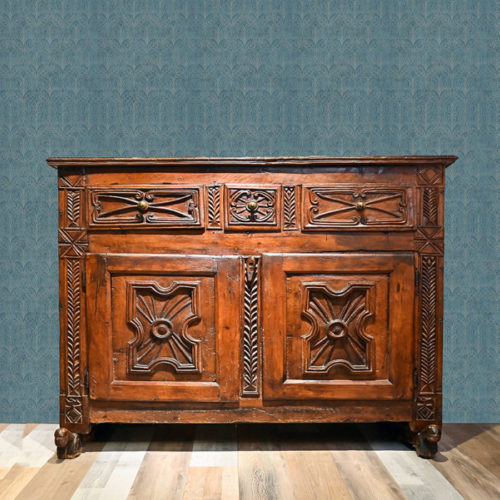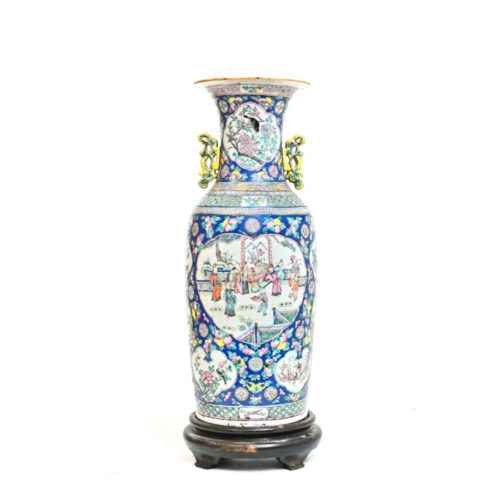Pair of Louis XVI style mirrors in carved and gilded lego with original glass.
-
Out of stock
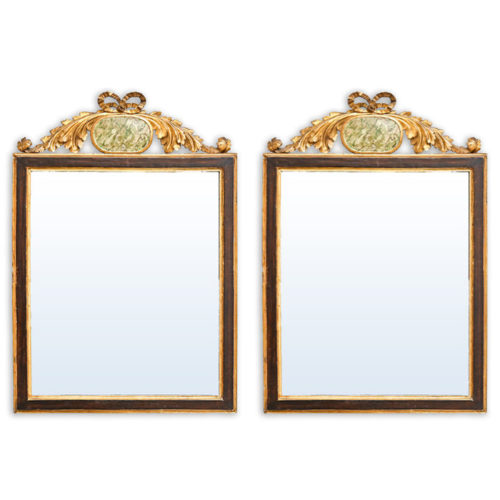 Period: End of the 18th century Measurements: H 72,5 x W 49,5 cm
Period: End of the 18th century Measurements: H 72,5 x W 49,5 cm -
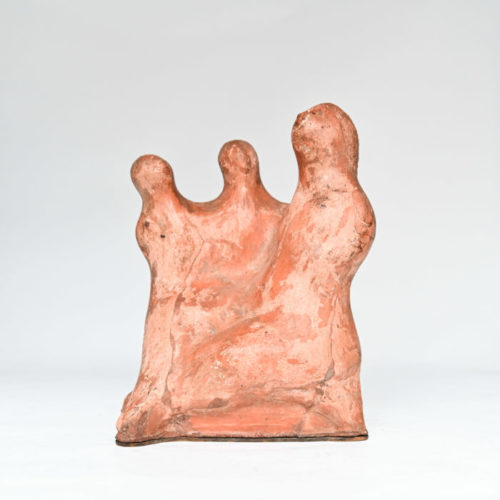 Period: 1949 Measurements: H 35 x W 26 x D 20 cmTerracotta sculpture by Carmelo Cappello (Ragusa, 21 May 1912 - Milan, 21 December 1996) signed and dated 1949. CARMELO CAPPELLO (Ragusa 1912 - Milan 1996) He attended the Comiso School of Art. Trained at a very young age in Ettore Colla's studio, he moved to Milan in the 30th. Thanks to a scholarship he follows the courses of Marino Marini at the Istituto Superiore di Monza. In 37 he made his debut as a sculptor and the following year he held his first solo show at the Bragaglia Gallery in Rome. In 41 he consolidated his friendship with Giò Ponti, which later became a close collaboration. He has participated numerous times in the Venice Biennale, the Rome Quadriennale and the Milan Triennale. In 59 he was invited to Documenta 2 in Kassel. After the first figurative phase, struck by Moore's modern European sculpture, he passes from Tatlin's Russian Constructivism to the discoveries of the filtering space of Pevsner, Brancusi and Gabo: these are the cultural matrices, in his artistic iter, of his original declination of pure linear rhythms and volumetric that constitute the fulcrum of his mature language. Constant components of its structures are the curve, linked in the circle or marked in the ellipsis, in a rigorous equilibrium of two-dimensional relationships. In Ragusa, in 94, the Civic Collection Cappello was inaugurated, the result of the donation of 15 sculptures and 20 graphic works that formed the starting point of the Museum dedicated to him in 55. Good production of multiples and graphics of his maturity.
Period: 1949 Measurements: H 35 x W 26 x D 20 cmTerracotta sculpture by Carmelo Cappello (Ragusa, 21 May 1912 - Milan, 21 December 1996) signed and dated 1949. CARMELO CAPPELLO (Ragusa 1912 - Milan 1996) He attended the Comiso School of Art. Trained at a very young age in Ettore Colla's studio, he moved to Milan in the 30th. Thanks to a scholarship he follows the courses of Marino Marini at the Istituto Superiore di Monza. In 37 he made his debut as a sculptor and the following year he held his first solo show at the Bragaglia Gallery in Rome. In 41 he consolidated his friendship with Giò Ponti, which later became a close collaboration. He has participated numerous times in the Venice Biennale, the Rome Quadriennale and the Milan Triennale. In 59 he was invited to Documenta 2 in Kassel. After the first figurative phase, struck by Moore's modern European sculpture, he passes from Tatlin's Russian Constructivism to the discoveries of the filtering space of Pevsner, Brancusi and Gabo: these are the cultural matrices, in his artistic iter, of his original declination of pure linear rhythms and volumetric that constitute the fulcrum of his mature language. Constant components of its structures are the curve, linked in the circle or marked in the ellipsis, in a rigorous equilibrium of two-dimensional relationships. In Ragusa, in 94, the Civic Collection Cappello was inaugurated, the result of the donation of 15 sculptures and 20 graphic works that formed the starting point of the Museum dedicated to him in 55. Good production of multiples and graphics of his maturity. -
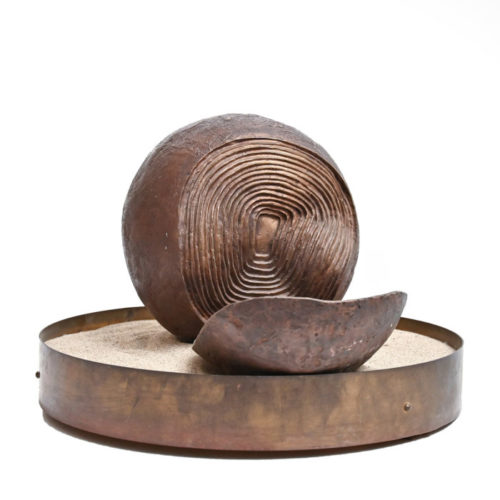 Period: 1976 Measurements: H32 x W48 x W48 cmBronze sculpture by Franco Zazzeri signed and dated 1976. "A sphere, and all of a sudden it breaks, a slice of it caught just in the moment of falling down (...) that sphere is configured as the earth that turns in spaces; what will become the segment that has detached from the sphere of Zazzeri? " - Marco Valsecchi 1977 (Milan, 1913 - 1980) - art critic, university professor, essayist and journalist of the daily newspapers Il Giorno and Il Giornale and of the weekly Lo Speciale. "Zazzeri's work can be called" totemism of the origins ": an anthropological function that rediscovers the notion of beauty in the recognition of an inner and eternal truth." - Riccardo Barletta 1985 - Modern art critic and professor of history of design at the Polytechnic School of Milan. "Cosmos and Logos are converted into each other, through the filter of the protean personality of Zazzeri" - Floriano De Santi 1999 - Artistic Director and Critic and art historian FRANCO ZAZZERI was born in Florence on 19 August 1938. He spent his childhood in Monte San Savino, Arezzo. At the age of fourteen he began working in a ceramics workshop but, fascinated by sculpture, he moved to Arezzo where he worked for a local marble worker and attended the Aretina art school under the guidance of the sculptor Giovanni Bianchi. At the end of the 1950s, commissioned by various personalities from Arezzo, he made several sculptural portraits; he wins the competition for the construction of the statue of the Madonna delle Vertighe (patron saint of the Autostrada del Sole). In 1960 he moved to Milan (where he currently lives and works). In the same year he graduated from the school of the Castello Sforzesco sculpture section. To his credit 30 personal exhibitions held in Italy and Europe. Numerous group exhibitions; we cite some of the most prestigious: 1983 "Italian sculpture in the world" traveling exhibition in the main cities of the world by the Ministry of Foreign Affairs and the Rome Quadrennial of Art; 1984 "XXIX Biennale of Art of the City of Milan", Palazzo della Permanente; 1986 "XLII International Biennial of Art of Venice"; 1989 "XXXI Biennale of Art of the City of Milan", Palazzo della Permanente; 1999 "XIII Quadrennial of Rome". Some of his sculptures are found in: Montecarlo - Banque de Gestion Monegasque; Rome - EUR - Italian Credit; Rome - via del corso 374 - Credito Italiano; Turin - in via Arsenale, 11 - Credito Italiano; Moscow - Italian Representation; Milan - Linate and Malpensa Airport; Milan - Municipality of Milan in via Pirelli; Milan - Piazza Duca d'Aosta; Milan - Civic Center - via Oglio 18; Here below we mention only a few other exhibitions, by importance and artistic significance: 2002 Milan, Palazzo Municipale Sondrio; 1995-1999-2005 Milan, Borgogna Gallery; 1989 Monte San Savino, "Homage to Sansovino"; 1984 Munich, Galerie Museum BMW; 1984 Vienna, Italian Cultural Institute; 1980 Ferrara, Palazzo Dei Diamanti; 1975-1979-1983 Ada Zunino Gallery; 1971-1974 Monza, Arengario Museum; 1970-1971-1972-1973 Milan, 'La Darsena' Gallery. "... Starting from a figurative sculpture Franco Zarreri soon turns to a more informal vision of the figure, a non-individual content emerges from the representation of the individual to that of the group, the family nucleus, seen as a reality of the primordium in a genetic sense . A non-descriptive and unrealistic position. ... " from "Zarreri - The Totemism of Origins" Riccardo Barletta ed. Milan Point and Line
Period: 1976 Measurements: H32 x W48 x W48 cmBronze sculpture by Franco Zazzeri signed and dated 1976. "A sphere, and all of a sudden it breaks, a slice of it caught just in the moment of falling down (...) that sphere is configured as the earth that turns in spaces; what will become the segment that has detached from the sphere of Zazzeri? " - Marco Valsecchi 1977 (Milan, 1913 - 1980) - art critic, university professor, essayist and journalist of the daily newspapers Il Giorno and Il Giornale and of the weekly Lo Speciale. "Zazzeri's work can be called" totemism of the origins ": an anthropological function that rediscovers the notion of beauty in the recognition of an inner and eternal truth." - Riccardo Barletta 1985 - Modern art critic and professor of history of design at the Polytechnic School of Milan. "Cosmos and Logos are converted into each other, through the filter of the protean personality of Zazzeri" - Floriano De Santi 1999 - Artistic Director and Critic and art historian FRANCO ZAZZERI was born in Florence on 19 August 1938. He spent his childhood in Monte San Savino, Arezzo. At the age of fourteen he began working in a ceramics workshop but, fascinated by sculpture, he moved to Arezzo where he worked for a local marble worker and attended the Aretina art school under the guidance of the sculptor Giovanni Bianchi. At the end of the 1950s, commissioned by various personalities from Arezzo, he made several sculptural portraits; he wins the competition for the construction of the statue of the Madonna delle Vertighe (patron saint of the Autostrada del Sole). In 1960 he moved to Milan (where he currently lives and works). In the same year he graduated from the school of the Castello Sforzesco sculpture section. To his credit 30 personal exhibitions held in Italy and Europe. Numerous group exhibitions; we cite some of the most prestigious: 1983 "Italian sculpture in the world" traveling exhibition in the main cities of the world by the Ministry of Foreign Affairs and the Rome Quadrennial of Art; 1984 "XXIX Biennale of Art of the City of Milan", Palazzo della Permanente; 1986 "XLII International Biennial of Art of Venice"; 1989 "XXXI Biennale of Art of the City of Milan", Palazzo della Permanente; 1999 "XIII Quadrennial of Rome". Some of his sculptures are found in: Montecarlo - Banque de Gestion Monegasque; Rome - EUR - Italian Credit; Rome - via del corso 374 - Credito Italiano; Turin - in via Arsenale, 11 - Credito Italiano; Moscow - Italian Representation; Milan - Linate and Malpensa Airport; Milan - Municipality of Milan in via Pirelli; Milan - Piazza Duca d'Aosta; Milan - Civic Center - via Oglio 18; Here below we mention only a few other exhibitions, by importance and artistic significance: 2002 Milan, Palazzo Municipale Sondrio; 1995-1999-2005 Milan, Borgogna Gallery; 1989 Monte San Savino, "Homage to Sansovino"; 1984 Munich, Galerie Museum BMW; 1984 Vienna, Italian Cultural Institute; 1980 Ferrara, Palazzo Dei Diamanti; 1975-1979-1983 Ada Zunino Gallery; 1971-1974 Monza, Arengario Museum; 1970-1971-1972-1973 Milan, 'La Darsena' Gallery. "... Starting from a figurative sculpture Franco Zarreri soon turns to a more informal vision of the figure, a non-individual content emerges from the representation of the individual to that of the group, the family nucleus, seen as a reality of the primordium in a genetic sense . A non-descriptive and unrealistic position. ... " from "Zarreri - The Totemism of Origins" Riccardo Barletta ed. Milan Point and Line -
Out of stock
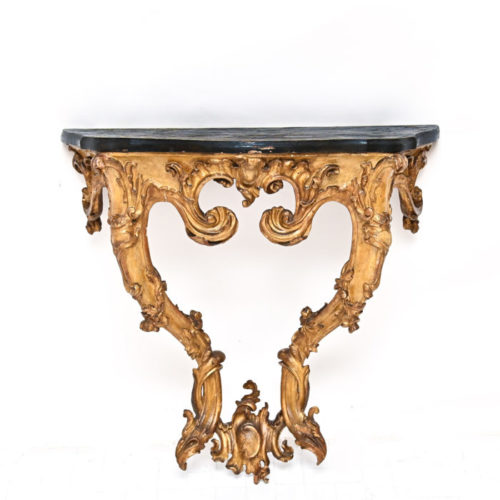 Consolle in carved and gilded wood in Louis XV style dating back to the mid-18th century. Original wooden top. In good condition. Period: Mid '700 Measurements: H 95 x W 94 x D 45 cm
Consolle in carved and gilded wood in Louis XV style dating back to the mid-18th century. Original wooden top. In good condition. Period: Mid '700 Measurements: H 95 x W 94 x D 45 cm

